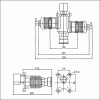RedSubmarine
New Member
I'm looking into the **broken link removed**. It says that at 70 mph it will deplete its 6 kWh battery in 43 miles, which is about 36.8 minutes of run time. I'm trying to figure out if I would be able to put a gas generator I have on it to give it more range.
The bike has a 6kWh/60V battery, a 1kW charger (that takes 6 hours to charge it fully plugged into the wall 110V), and a 420 amp "controller" that meters the flow of electricity to the motor.
My generator puts out up to 55V of AC or 18V of DC power at 500 rpm. The most amps I've gotten out of it is 60 amps into a 12V battery, which is about 700 watts. The generator is home made, so there's not really any factory output numbers to use, just my measurements.
I would really appreciate it if someone on here could help me figure out if my generator would make a difference in range or not at that speed.
The bike has a 6kWh/60V battery, a 1kW charger (that takes 6 hours to charge it fully plugged into the wall 110V), and a 420 amp "controller" that meters the flow of electricity to the motor.
My generator puts out up to 55V of AC or 18V of DC power at 500 rpm. The most amps I've gotten out of it is 60 amps into a 12V battery, which is about 700 watts. The generator is home made, so there's not really any factory output numbers to use, just my measurements.
I would really appreciate it if someone on here could help me figure out if my generator would make a difference in range or not at that speed.

